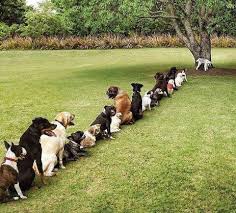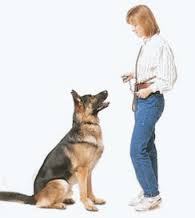Setting house rules makes life easier for everyone. It also prevents disagreements that often cause stress and confusion, particularly for dogs. Here are 5 house rules established by world renowned dog trainer Victoria Stillwell.

 1.) Create Boundaries. A home without boundaries and rules is a disaster waiting to happen. While it is a myth that dogs assume the Alpha position and take over your home if you do not assert your authority as a pack leader, your dog still needs to be taught what she can and cannot do. Choose areas of the home that you would like to be off limits, and set clear boundaries for behaviors that you find inappropriate, such as jumping and counter surfing. If your dog engages in these behaviors, try management and training techniques that focus on teaching an alternate positive behavior rather than repeated punishment for the negative. For example, instead of pushing your dog off and yelling No when she jumps up on people, teach her to approach them and get their attention by standing or sitting in front of them rather than jumping up.
1.) Create Boundaries. A home without boundaries and rules is a disaster waiting to happen. While it is a myth that dogs assume the Alpha position and take over your home if you do not assert your authority as a pack leader, your dog still needs to be taught what she can and cannot do. Choose areas of the home that you would like to be off limits, and set clear boundaries for behaviors that you find inappropriate, such as jumping and counter surfing. If your dog engages in these behaviors, try management and training techniques that focus on teaching an alternate positive behavior rather than repeated punishment for the negative. For example, instead of pushing your dog off and yelling No when she jumps up on people, teach her to approach them and get their attention by standing or sitting in front of them rather than jumping up.
 2.) Set a House training Schedule. Your dog MUST understand where it is appropriate to go potty. The key to easy house training is a combination of a regular potty/feeding/exercise and play schedule, along with consistency and patience. If you have a young puppy, crate training can be especially helpful, but take your pup outside for regular potty breaks to prevent accidents. The more you stick to a consistent schedule, the quicker your dog will learn.
2.) Set a House training Schedule. Your dog MUST understand where it is appropriate to go potty. The key to easy house training is a combination of a regular potty/feeding/exercise and play schedule, along with consistency and patience. If you have a young puppy, crate training can be especially helpful, but take your pup outside for regular potty breaks to prevent accidents. The more you stick to a consistent schedule, the quicker your dog will learn.
 3.) Teach Basic Cues. Basis cues are a great way to communicate and teach your puppy the fundamental skills needed to implement the house rules. Dogs of any breed and age can learn cues such as sit, stay and come. Just understand why you are teaching these cues, and do not overuse them. If you feel like your dog is uninterested in learning, try a different motivator. Some dogs are motivated by food, while others respond to toys, praise, or a combination of rewards. Every dog needs to feel good about learning, so keep training sessions short and fun. Be consistent with the words you use and the way you handle your dog. If you teach your dog that “down” means lie down, do not use the same word to tell your dog to get off something.
3.) Teach Basic Cues. Basis cues are a great way to communicate and teach your puppy the fundamental skills needed to implement the house rules. Dogs of any breed and age can learn cues such as sit, stay and come. Just understand why you are teaching these cues, and do not overuse them. If you feel like your dog is uninterested in learning, try a different motivator. Some dogs are motivated by food, while others respond to toys, praise, or a combination of rewards. Every dog needs to feel good about learning, so keep training sessions short and fun. Be consistent with the words you use and the way you handle your dog. If you teach your dog that “down” means lie down, do not use the same word to tell your dog to get off something.
 4.) Hire A Trainer. Whether you take your dog to group classes or hire a dog trainer to help you at home with the house rules, check that the trainer is certified by a reputable organization. If you are ever uncomfortable with any methods a dog trainer is using on your dog, voice your concerns. All dogs need some kind of canine education that incorporates life skills, such as learning cues, problem solving, socializing, impulse control and basis manners.
4.) Hire A Trainer. Whether you take your dog to group classes or hire a dog trainer to help you at home with the house rules, check that the trainer is certified by a reputable organization. If you are ever uncomfortable with any methods a dog trainer is using on your dog, voice your concerns. All dogs need some kind of canine education that incorporates life skills, such as learning cues, problem solving, socializing, impulse control and basis manners.
 5.) Be Consistent. No amount of training will be successful long term without the entire family’s commitment to consistency. Your dog can get confused and frustrated if one person allows her to get on the sofa, while others punish her for doing so. Consistency makes learning easier and will give your dog the confidence she needs to be successful within her environment.
5.) Be Consistent. No amount of training will be successful long term without the entire family’s commitment to consistency. Your dog can get confused and frustrated if one person allows her to get on the sofa, while others punish her for doing so. Consistency makes learning easier and will give your dog the confidence she needs to be successful within her environment.






